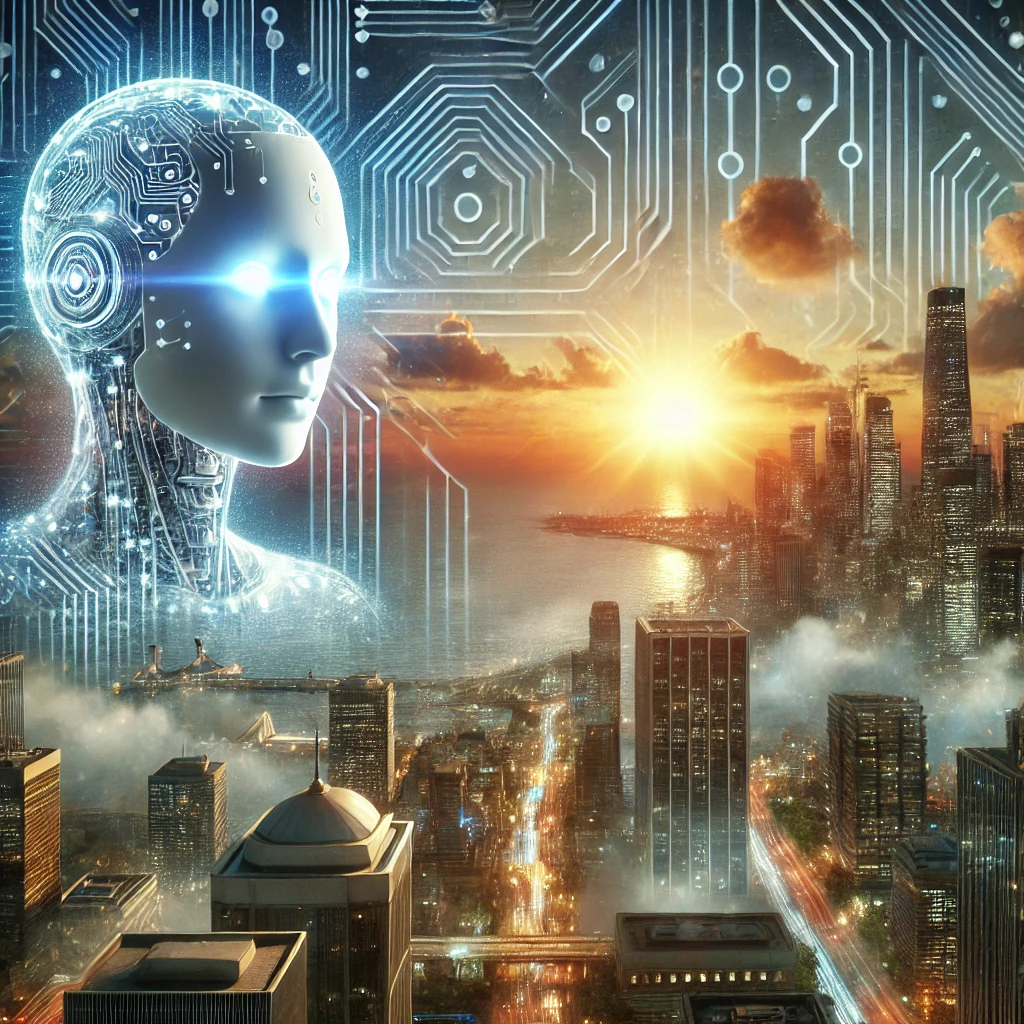The Dawn of AI, The field of Artificial Intelligence, once a realm of science fiction, has rapidly become an integral part of our lives. From self-driving cars to personalized recommendations, AI’s influence is undeniable. Understanding its current state requires a journey back to its technological roots, exploring the key milestones and foundational concepts that paved the way for this transformative technology. This article traces the dawn of AI, examining the contributions of early computing, the theoretical underpinnings of logic and automata, the interdisciplinary field of cybernetics, and the pivotal Dartmouth Workshop that formally launched the field.
Early Computing: The Foundation
The very idea of artificial intelligence relies on the ability to automate complex calculations and processes, a capability that emerged with the development of early computing machines. Charles Babbage’s conceptual Analytical Engine, designed in the 19th century, though never fully built, embodied the principles of programmable computation, laying the groundwork for future computers. Ada Lovelace’s work on the Analytical Engine, including the first published algorithm intended for machine execution, further cemented the connection between machines and logical processes.
The advent of electronic computers in the 20th century marked a significant leap forward. The Colossus, built during World War II to break German codes, demonstrated the immense power of electronic computation. ENIAC, the first general-purpose electronic digital computer, further expanded the possibilities of automated calculation. These machines, while not intelligent in the modern sense, provided the essential hardware platform upon which AI research could flourish.
The development of stored-program computers, with the ability to store and modify instructions in memory, was a crucial step towards more flexible and adaptable machines. This architecture, pioneered by figures like John von Neumann, allowed computers to execute complex sequences of operations without physical reconfiguration, a key feature for implementing AI algorithms. The increasing speed and memory capacity of these machines also played a vital role in enabling more sophisticated computational tasks.
High level Programming
The emergence of high-level programming languages, such as FORTRAN and COBOL, further abstracted the complexities of machine code, making it easier for programmers to develop complex software. These languages provided a more intuitive and human-readable way to interact with computers, facilitating the development of more sophisticated algorithms and programs, including those related to early AI research.
The evolution of hardware and software went hand in hand, with advancements in one area driving progress in the other. The miniaturization of transistors and the development of integrated circuits led to smaller, faster, and more affordable computers, making them accessible to a wider range of researchers and developers. This democratization of computing power further fueled the growth of the field.
The foundational work in early computing provided the necessary tools and infrastructure for the exploration of artificial intelligence. Without the ability to perform complex calculations and manipulate symbolic information, the pursuit of AI would have remained a theoretical exercise. These early machines, though limited by today’s standards, paved the way for the development of the sophisticated AI systems we see today.
Seeds of AI: Logic and Automata
The theoretical foundations of AI draw heavily from the fields of logic and automata theory. Formal logic, with its rigorous systems for representing and manipulating knowledge, provided a framework for expressing reasoning and decision-making processes in a computational manner. Boolean algebra, developed by George Boole, provided a mathematical framework for representing logical operations using binary values, a fundamental concept in digital computing.
The work of Alan Turing, particularly his concept of the Turing machine, revolutionized the understanding of computation and its potential limits. The Turing machine, a theoretical device that can manipulate symbols on a tape according to a set of rules, provided a formal model for computation and laid the groundwork for the study of computability and algorithm design. This model became a cornerstone of theoretical computer science and played a significant role in shaping the early development of AI.
Automata Theory
Automata theory, the study of abstract self-operating machines, offered another crucial perspective on the possibility of artificial intelligence. The concept of finite state machines, which can transition between a finite number of states based on input symbols, provided a model for designing systems that could react to their environment in a predetermined manner. This concept proved valuable in developing early AI systems capable of performing simple tasks.
The development of formal language theory, closely related to automata theory, further contributed to the understanding of how machines could process and understand language. Noam Chomsky’s work on generative grammars provided a formal framework for describing the structure of natural languages, paving the way for research in natural language processing, a core area of AI.
The exploration of symbolic reasoning, the ability to manipulate symbols according to logical rules, became a central focus of early AI research. Researchers sought to develop programs that could solve problems, prove theorems, and even engage in simple conversations by manipulating symbolic representations of knowledge. This approach, known as symbolic AI, dominated the field for several decades.
The interplay between logic, automata theory, and formal language theory provided the intellectual scaffolding for the development of AI. These theoretical frameworks provided a rigorous foundation for understanding computation, representation, and reasoning, enabling researchers to explore the possibility of creating machines capable of intelligent behavior.
Cybernetics: Bridging Mind & Machine
Cybernetics, an interdisciplinary field that emerged in the mid-20th century, played a crucial role in shaping the early development of AI. Focusing on the study of control and communication in both animals and machines, cybernetics emphasized the parallels between biological and artificial systems. This perspective fostered the idea that intelligence could be understood and potentially replicated in artificial systems.
Cybernetcs feedback
Norbert Wiener, a prominent figure in cybernetics, explored the concept of feedback loops and their importance in regulating complex systems. Feedback loops, where the output of a system influences its future input, provided a mechanism for adapting to changing environments and achieving desired goals. This concept became fundamental in the design of control systems and influenced the development of early AI systems.
The study of biological systems, particularly the nervous system, provided valuable insights for AI researchers. Understanding how biological brains process information and control behavior inspired the development of artificial neural networks, computational models inspired by the structure and function of biological neurons. These early neural networks, though limited in their capabilities, laid the groundwork for the resurgence of deep learning in recent decades.
Robotics Development
Cybernetics also contributed to the development of robotics, the field concerned with designing and building robots. The integration of control systems, sensors, and actuators allowed researchers to create machines capable of interacting with the physical world, a crucial step towards building embodied AI systems. Early robots, though often simple in their design, demonstrated the potential for creating artificial agents capable of performing physical tasks.
The concept of self-organizing systems, systems that can spontaneously develop complex structures and behaviors without external control, also emerged from cybernetics. This concept, inspired by biological phenomena such as the formation of patterns in nature, influenced the development of AI algorithms capable of learning and adapting without explicit programming.
Cybernetics provided a crucial bridge between the study of biological intelligence and the development of artificial intelligence. By highlighting the common principles of control, communication, and feedback in both biological and artificial systems, cybernetics helped to shape the early development of AI and paved the way for future advancements.
The Dartmouth Workshop: AI is Born
The Dartmouth Workshop, held in the summer of 1956, is widely considered the birth of artificial intelligence as a formal field of study. Organized by John McCarthy, Marvin Minsky, Claude Shannon, and Nathaniel Rochester, the workshop brought together leading researchers from various disciplines to explore the possibility of creating machines capable of intelligent behavior.
The proposal for the workshop, written by McCarthy et al., outlined an ambitious agenda for the two-month event. The proposal stated that “every aspect of learning or any other feature of intelligence can in principle be so precisely described that a machine can be made to simulate it.” This bold statement set the tone for the workshop and laid the foundation for the field’s initial optimism and ambitious goals.
Dartmouth Workshop
The Dartmouth Workshop explored a wide range of topics relevant to AI, including natural language processing, neural networks, and problem-solving. Participants engaged in lively discussions and debates, sharing their ideas and laying the groundwork for future research collaborations. The workshop fostered a sense of community among AI researchers and helped to define the field’s initial research directions.
One of the key outcomes of the Dartmouth Workshop was the adoption of the term “artificial intelligence” itself. John McCarthy coined the term, which quickly gained widespread acceptance and became the standard name for the burgeoning field. This naming convention solidified the field’s identity and helped to attract further research and funding.
Although the Dartmouth Workshop did not produce immediate breakthroughs in AI, it established a shared vision and research agenda for the field. The workshop fostered a sense of excitement and optimism about the potential of AI and laid the foundation for the rapid growth and development of the field in the following decades.
The Dartmouth Workshop marked a turning point in the history of AI, transitioning from a collection of disparate ideas to a recognized field of study. The workshop’s legacy lies not only in its formalization of the field but also in the intellectual ferment it generated, inspiring generations of researchers to pursue the ambitious goal of creating truly intelligent machines.
Mechanical Cogs
From the mechanical cogs of Babbage’s Analytical Engine to the sophisticated algorithms powering today’s AI systems, the journey has been long and fascinating. The seeds of AI, sown in the fields of early computing, logic, automata theory, and cybernetics, found fertile ground at the Dartmouth Workshop, where the field formally took root. Understanding these technological roots provides crucial context for appreciating the current state of AI and anticipating its future trajectory. As AI continues to evolve at an unprecedented pace, remembering its origins serves as a reminder of the ingenuity and vision that have propelled this transformative technology forward.
Additonal topics on AI can be found here






